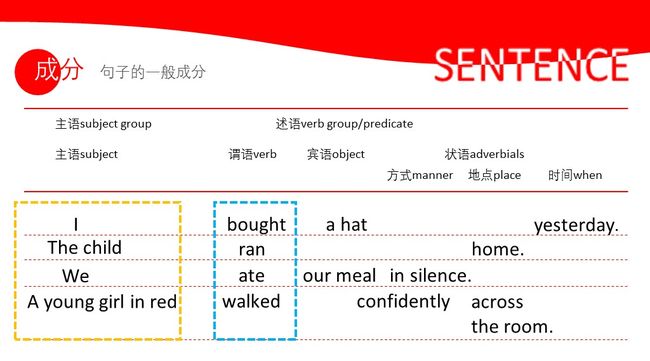上次说及物动词句型有三种:
句型3:主语(S)+动词(V)+宾语(O)
句型4:主语(S)+动词(V)+间接宾语(o)+直接宾语(O)
句型5:主语(S)+动词(V)+宾语(O)+补语(C)
(一)
句型3:主语(S)+动词(V)+宾语(O)
这是最常见的一种句型,还记得这张表吗?
其实就是第3种句型的句子顺序。作宾语的可以是:
名词:We parkedthe carin the park.
代词:We fetchedherfrom the station.
反身代词:We enjoyedourselvesat the party.
不定式:I wantto go homenow.
动词-ing形式(动名词):I enjoyedsittingin the sun.
有一部分动词相对特殊,其宾语后不跟间接宾语,而是加to+名词/代词或是for+名词/代词。
常见的这类动词结构有:
1. 表示“向谁……说”
announce sth. to sb.:
The host announced the winner to theaudience.
主持人向观众宣布了获胜者。
confess sth. to sb.:
The thief confessed his crime to the police.
小偷向警察承认了犯罪事实。
类似含义的和用法的动词还有declare(宣布), demonstrate(展示),explain(解释),introduce(介绍),mention(提到),propose a toast to (提议为…举杯),report(报告),say(说), state(陈述), suggest(建议).
2.表示托付给……(信任的)人
confide sth. to sb.:
I confided my worries to Michael.
我把我的担心透露给了迈克。
The president confided the task of drafting the report to her assistant.
总统把起草报告的任务委托给他的助手。
类似含义和用法的还有:entrust(委托、交付),
3. (for+名词/代词)
describe sth for sb.:
Would you describe it for me please?
你能给我描述一下吗?
(二)
句型4:主语(S)+动词(V)+ 间接宾语(o)+直接宾语(O)
像bring, buy, give这类动词通常可以跟2个宾语,间接宾语通常紧跟在动词后面,通常指人。
如:
The firm gaveSama gold watch.
Sam——间接宾语,a gold watch——直接宾语。
通常间接宾语紧跟在动词后,但也可以用“to+间接宾语”或“for+间接宾语”结构代替间接宾语(也就是变成了句型3)。如:
The firm gave a gold watchto Sam.
They bought a gold watchfor Sam.
使用to+间接宾语的常见动词有:bring, give, grant, hand, leave, lend, offer, owe, pass, pay, play, post, promise, read, recommend, sell, send, serve, show, sing, take, teach, tell, throw, write.
使用for+间接宾语的常见动词有:bring, build, buy, call, catch, change, choose, cook, cut, do, fetch, find, fix, get, keep, leave, make, order, prepare, reach, reserve, save, sing
还有一类动词直接宾语通常可以省略,因为其直接宾语是固定的、唯一的或约定俗成的,如I’ll write you a letter. 也可以说, I’ll write you. I'll tell you the truth soon. 说I’ll tell you soon也没有问题。这类动词包括ask, bet, forgive, grant, owe, pay, promise, show, show, teach, tell. write.
如果直接宾语和间接宾语同为代词,对于bring, buy, fetch, hand, pass, send, show和 teach而言,其顺序可以交换,特别是在口语中,如
give me it/give it me
show me it/show it me
pass me it/pass it me
当然,前一组更常见,不过后一组在语法上也是正确的。
(三)
主语(S)+动词(V)+宾语(O)+补语(C)
句型5的常见动词有:appoint, baptize, call, consider, christen, crown, declare, elect, label, make, name, proclaim, pronounce, vote.
补语通常为名词、形容词
补语为名词:They appointed him chairman.
They made Sam redundant.
动词call, consider, declare, make, pronounce后面的补语也可以是形容词:
They called him foolish/a fool.
其他常见的宾语+形容词做补语结构:
drive (me) crazy/mad/wild
get (it) clean/dirty
find (it) difficult/easy
hold (it) open/still
keep (it) cool/fresh/shut
leave (it) clean/dirty
open (it) wide
paint (it) brown/red
prefer (it) fried
pull (it) shut/tight
want (it) raw
wipe (it) clean/dry
括号中的宾语可以替换,后面的形容词补充说明了动词动作的程度或动作完成后最终给宾语造成的状态。如:
Loud music drives me crazy.
